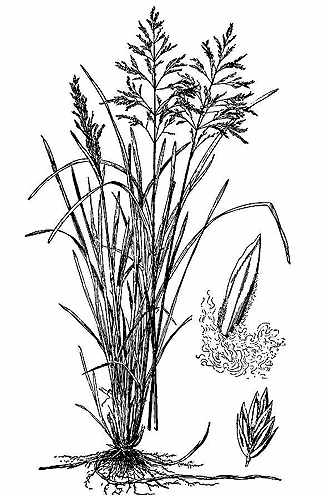Your Perspective on Your Grasslands in the Northern Plans (Non-Respondents) (Individuals)
Your Perspective on your Grasslands in the Northern Great Plains.
ARS - Survey_Final For Collection 0518-XXXX_Clean for OMB_cover1
Your Perspective on Your Grasslands in the Northern Plans (Non-Respondents) (Individuals)
OMB: 0518-0048
Your Perspective on your land in
the Northern Great Plains

A Survey For: Conducted By:
|
|
Northern Great Plains Research Lab:
Mandan, ND
USDA Confidentiality Statement:
The information you provide will be used for statistical purposes only. In accordance with the Confidential Information Protection provisions for Title V, Subtitle A, Public Law 107-347 and other applicable Federal laws, your responses will be kept confidential and will not be disclosed in identifiable form to anyone other than employees or agents. By law, any ARS employee as well as every agent such as contractors and authorized researchers is subject to a jail term of up to 5 years, a fine of up to $250,000, or both if he or she discloses ANY identifiable information about you.
Your response is voluntary and is estimated to take 15 minutes.
ID#Introduction
The grasslands and rangelands of North Dakota are a natural resource used by a wide variety of landowners. Producers, wildlife enthusiasts, and rural residents all share this resource and may have different opinions about land use.
To better understand and address current issues in the Northern Great Plains, we’d like to ask you about your opinions and experiences in this area. Specifically, we want to know:
your unique perspective about the land you own,
your perceptions of vegetation changes on the landscape, and
your use of land management practices.
Some sections of the survey ask about rangelands. By rangeland we mean natural land with native prairie grasses that has never been broken out into crop land or re-seeded/planted with other species.
We will also use the term place throughout the survey. Your place is all of the rural land you own outside of any city limits. If you own multiple rural properties in the counties listed below, please consider them all together in terms of one overall place:
Study Area:
B
 arnes
County
arnes
CountyBillings County
Burleigh County
Cass County
Golden Valley County
Kidder County
Morton County
Stark County
Stutsman County
The nine North Dakota counties included in this study.
Your response will be a great help!
Begin Survey
Section A: First, we invite you to tell us a bit about you and your place
Who makes most of the day-to-day decisions about your land?
Just me or Me and my spouse
Me and others (family members, business partners, land managers, leasee, etc.)
Only others (family members, business partners, land managers, leasee, etc.)
In a typical week, about how many hours do you spend managing, operating, or working on your place?
_______ hours

We’d like to understand how you use your land. Please indicate how important each of the following land uses are to you.
Land use: |
|
||
For a livestock operation |
|
|
|
For a crop production operation |
|
|
|
For an integrated crop and livestock operation |
|
|
|
For a commercial hunting enterprise (game ranch, private hunting leases, etc.) |
|
|
|
For commercial agrotourism or ecotourism …... |
|
|
|
For wildlife management and/or conservation (non-commercial) |
|
|
|
For personal outdoor recreation or to enjoy the rural lifestyle (non-commercial) |
|
|
|
For an investment in land/real estate |
|
|
|
Please use space below if we missed something important: |
|
|
|
Other: ________________________________________________ |
|
|
|
Of the land uses listed above, how do you primarily use your land?
Write in only one: ___________________________________________
How many years have you personally owned your place? _______ years
Did you inherit or acquire any of your land from your family? Yes No
Do you live on your place full-time?
Yes
No How many miles, one way, is your closest parcel of property from your primary residence?
________ miles
We’d like to learn more about how you think about your place. Please tell us the extent to which the items below describe your beliefs.
My place… |
|
||||
represents my way of life …... |
|
|
|
|
|
represents generations of my family’s history in the area |
|
|
|
|
|
reflects important aspects of who I am |
|
|
|
|
|
is a source of personal pride …... |
|
|
|
|
|
Is somewhere I enjoy the process of working on the land as much as the results |
|
|
|
|
|
is somewhere I feel more like a caretaker than an owner |
|
|
|
|
|
is where I do the kind of work I love |
|
|
|
|
|
I rely on my place… |
|
||||
to operate as a business …... |
|
|
|
|
|
to provide habitat for wildlife |
|
|
|
|
|
to make a profit |
|
|
|
|
|
to grow crops …... |
|
|
|
|
|
for the rangeland where I graze livestock |
|
|
|
|
|
We would like to know how farming and ranching may currently fit into your life. Please indicate to what extent each statement describes you.

I am a farmer …... |
|
|
|
|
|
I am a rancher |
|
|
|
|
|
A lot of my life is organized around farming/ranching |
|
|
|
|
|
Farming/ranching is an important part of who I am …... |
|
|
|
|
|
Landowners and producers often have different approaches to making decisions about their land. To what degree does each statement describe your approach to land management?
When making land management decisions, I focus on doing what… |
|
||||
has traditionally been done |
|
|
|
|
|
will provide the best outcomes in the short-term |
|
|
|
|
|
others think I should do |
|
|
|
|
|
I think is morally right …... |
|
|
|
|
|
improves conditions for future generations |
|
|
|
|
|
people I respect are doing |
|
|
|
|
|
will give me the biggest return on my investment |
|
|
|
|
|
other landowners around me are doing |
|
|
|
|
|
is best for the health of the land |
|
|
|
|
|
maintains or enhances my reputation |
|
|
|
|
|
will provide the best long-term outcomes |
|
|
|
|
|
is appropriate for someone like me to do in the situation………………………………………….. |
|
|
|
|
|
minimizes risk |
|
|
|
|
|
requires the least labor |
|
|
|
|
|
requires the least financial inputs |
|
|
|
|
|
Section B: Land management practices
In a typical year, do you use the following management practices on your rangelands?
-
Yes
No
Intensive livestock grazing in early spring (e.g., April & May) ……..……...
Prescribed fire (i.e., burning rangelands) .….………………………….…….
Targeted application of chemical herbicides ..……………………….……..
Mob grazing (i.e., ultra-high animal density for short durations) ………….
Multi-species grazing (e.g., sheep, goats, cattle, etc.) ..…………………...
Season-long grazing (e.g., May/June to October) …………………………
Do you use an integrated crop and livestock system?
No
Yes Please specify:
Practice(s) ___________________________________________
Crop(s)______________________________________________
Animal(s)_____________________________________________
Do you practice mob grazing? By mob grazing, we mean ultra-high density animal stocking for short durations.
No
Yes Please specify your:
Stocking rate: ________ (head/acre) or ________ (lbs/acre)
Number of daily moves: __________
Grazing period (months): ________________________________
About how many head of livestock do you typically run on your place?
-
Cattle (Cow-calf):
__________ pairs
Cattle (Yearlings):
__________ head
Cattle (Bulls):
__________ head
Horses:
__________ head
Other livestock: __________
__________ head
Section C: Your opinions on a new grass species
We’d like to understand the factors that influence your evaluation of a new grass species in rangelands. The following scenarios each present a description of a grass species that has different key characteristics once it becomes established. Please consider each description independently and indicate A) how acceptable or unacceptable the grass species is, and B) how you would manage the grass on your land.
_______________________
Description of Grass 1:
A new grass species is expanding onto your native rangelands. Based on current research and the best available information from other landowners, you know that once established this grass:
Leads to a moderate decrease (loss of 3-5 species) in the variety of grassland birds.
Doesn’t change the amount of floral resources that provide pollen and nectar for pollinator species.
Moderately decreases (20% less) water infiltration into the soil and the amount of water available to other plants.
Provides average (in terms of crude protein) quality forage for livestock during the primary growing period of this species.
Provides palatable forage for livestock only late in the grazing season (September, October, November).
Moderately decreases (loss of 20%) the diversity of other grasses.
Produces a higher than average (25% more) yield in terms of lbs/acre.
From your point of view, how acceptable or unacceptable is this species on your rangelands?
-

How would you manage this grass species on your rangelands?

-
Description of Grass 2:
A new grass species is expanding onto your native rangelands. Based on current research and the best available information from other landowners, you know that once established this grass:
Doesn’t change the variety of grassland birds.
Doesn’t change the amount of floral resources that provide pollen and nectar for pollinator species.
Moderately increases (20% more) water infiltration into the soil and the amount of water available to other plants.
Provides higher than average (25% more crude protein) quality forage for livestock during the primary growing period of this species.
Provides palatable forage for livestock only early in the grazing season (April & May).
Greatly decreases (loss of 50% or more) the diversity of other grasses.
Produces an average yield in terms of lbs/acre.
From your point of view, how acceptable or unacceptable is this species on your rangelands?
-

How would you manage this grass species on your rangelands?

-
Description of Grass 3:
A new grass species is expanding onto your native rangelands. Based on current research and the best available information from other landowners, you know that once established this grass:
Doesn’t change the variety of grassland birds.
Leads to a moderate decrease (loss of 15%) in the amount of floral resources that provide pollen and nectar for pollinator species.
Doesn’t change water infiltration into the soil and the amount of water available to other plants.
Provides higher than average (25% more crude protein) quality forage for livestock during the primary growing period of this species.
Provides palatable forage for livestock only during the summer grazing season (June, July, August).
Has no effect on the diversity of other grasses.
Produces a lower than average (25% less) yield in terms of lbs/acre.
From your point of view, how acceptable or unacceptable is this species on your rangelands?
-

How would you manage this grass species on your rangelands?

-
Description of Grass 4:
A new grass species is expanding onto your native rangelands. Based on current research and the best available information from other landowners, you know that once established this grass:
Leads to a moderate increase (gain of 3-5 species) in the variety of grassland birds.
Leads to a moderate increase (gain of 15%) in the amount of floral resources that provide pollen and nectar for pollinator species.
Moderately decreases (20% less) water infiltration into the soil and the amount of water available to other plants.
Provides lower than average (25% less crude protein) quality forage for livestock during the primary growing period of this species.
Provides palatable forage for livestock only late in the grazing season (September, October, November).
Has no effect on the diversity of other grasses.
Produces a lower than average (25% less) yield in terms of lbs/acre.
From your point of view, how acceptable or unacceptable is this species on your rangelands?
-

How would you manage this grass species on your rangelands?

-
Section D: Your opinions on kentucky bluegrass/june grass

Kentucky bluegrass (Poa pratensis L.) is most known as a lawn and turf grass. A variety of this cool-season, perennial grass grows in the grasslands and rangelands of North Dakota.
Kentucky bluegrass is sometimes called June grass because it matures early in the growing season and usually dries out and produces seed in June.
We want to know your opinions about Kentucky bluegrass even if it does not currently grow on your land.
How familiar are you with Kentucky bluegrass?
Not familiar

Drawing of Kentucky bluegrass courtesy of USDA-NRCS PLANTS Database.
Slightly familiar
Moderately familiar
Very familiar
Extremely familiar
Do you currently have Kentucky bluegrass on your rangelands?
No
Unsure
Yes
Of the rangelands you own and operate, what is your best estimate of the percentage of this land that has Kentucky bluegrass present?
________ %
Of the rangelands you own and operate that contain Kentucky bluegrass, approximately how much of the plant community is bluegrass?
________ %
Please think about your history on your place. From your perspective, has the abundance of Kentucky bluegrass on your rangeland:
Definitely decreased
Probably decreased
Remained about the same
Probably increased
Definitely increased
Based on your own preferences, would you say the abundance of bluegrass on your rangeland is:
Much too low
Too low
About right
Too high
Much too high
Landowners and producers in North Dakota manage their land for a variety of uses. Some folks may like Kentucky bluegrass while others do not. We’d like your opinions about bluegrass even if you don’t have any on your land.
Please indicate the degree to which you think the following statements about bluegrass are true or not.
Kentucky bluegrass…
|
|
||||
is a valuable source of forage for livestock in the spring and early summer |
|
|
|
|
|
is preferred by livestock over other grass species during its primary growing period |
|
|
|
|
|
decreases the amount of forage available for livestock over the entire growing season |
|
|
|
|
|
increases the number of wildlife species in rangelands …... |
|
|
|
|
|
reduces soil erosion |
|
|
|
|
|
increases soil quality |
|
|
|
|
|
increases the amount of water available in the soil |
|
|
|
|
|
outcompetes other grasses and forbs |
|
|
|
|
|
improves the natural beauty of rangeland landscapes |
|
|
|
|
|
decreases my ability to cope with drought |
|
|
|
|
|
reduces the number of pollinator species in rangelands |
|
|
|
|
|
maintains its nutritional value once mature (i.e., once it produces seed and dries out) |
|
|
|
|
|
makes rangelands less pristine |
|
|
|
|
|
Section E: Management perspectives
In general, which option below best describes your goal for Kentucky bluegrass on your rangelands?
My goal is to increase the abundance of bluegrass on my rangelands to _____ %.
My goal is to maintain the current abundance of bluegrass on my rangelands.
My goal is to decrease the abundance of bluegrass on my rangelands to _____ %.
I have no goal for the abundance of bluegrass on my rangelands.
Overall, having Kentucky bluegrass on my rangelands is (or would be):


![]()
![]()
![]()


Undesirable |
|
|
|
|
|
|
|
Desirable |
Encouraging |
|
|
|
|
|
|
|
Threatening |
Good |
|
|
|
|
|
|
|
Bad |
Worthless |
|
|
|
|
|
|
|
Valuable |
Beneficial |
|
|
|
|
|
|
|
Detrimental |
Unacceptable |
|
|
|
|
|
|
|
Acceptable |
On my rangelands, I can effectively manage Kentucky bluegrass at the levels I desire.
Strongly disagree
Disagree
Neither agree nor disagree
Agree
Strongly agree
We are also interested in what opinions you think other landowners and producers might have about Kentucky bluegrass. We don’t expect that you know exactly what others are thinking but we’d like you to answer these questions based on your general impressions.
Most landowners I know want to ____________ the abundance of bluegrass on their rangelands.
maintain
increase
decrease
do nothing about the
Most landowners I know ____________ control bluegrass on their rangelands.
never
rarely
sometimes
usually
always
Most landowners I know _________________ control bluegrass on my rangelands.
definitely think I should not
probably think I should not
do not care whether I
probably think I should
definitely think I should
Most landowners I know would ____________ if I controlled for bluegrass on my rangelands.
strongly disapprove
disapprove
neither disapprove or approve
approve
strongly approve
Section F: Managing kentucky bluegrass on your land
Please skip to Section F if you do not have Kentucky bluegrass on your land.
Over the next 12 months, how likely or unlikely are you to use each practice specifically to manage Kentucky bluegrass on your rangelands?
|
Extremely unlikely |
Unlikely |
Neither unlikely or likely |
Likely |
Extremely likely |
Intensive livestock grazing in early spring (e.g., April & May) |
|
|
|
|
|
Prescribed fire (i.e., burning rangelands) |
|
|
|
|
|
Targeted application of chemical herbicides ………………………………... |
|
|
|
|
|
Mob grazing (i.e., ultra-high animal density for short durations) |
|
|
|
|
|
Multi-species grazing (e.g., sheep, goats, cattle, etc.) |
|
|
|
|
|
Use space if we missed a practice you intend to use to manage bluegrass: Other practice: _________________________ |
|
|
|
|
|
Please tell us whether you have used each of the following practices specifically to manage bluegrass on your rangelands recently and/or in the past.
|
|
|
|
|
To manage bluegrass, I have used: |
Never |
ONLY more than 2 years ago |
ONLY in last 2 years |
More than 2 years ago AND in last 2 years |
Intensive livestock grazing in early spring (e.g., April & May) |
|
|
|
|
Prescribed fire (i.e., burning rangelands) |
|
|
|
|
Targeted application of chemical herbicides |
|
|
|
|
Mob grazing (i.e., ultra-high animal density for short durations) |
|
|
|
|
Multi-species grazing (e.g., sheep, goats, cattle, etc.) |
|
|
|
|
Use space if we missed a practice you have used to manage bluegrass: Other practice: ________________________ |
|
|
|
|

How effective do you think each management practice is at controlling/reducing Kentucky bluegrass?
|
|
|
|
|
|
Intensive livestock grazing in early spring (e.g., April & May) …......... |
|
|
|
|
|
Prescribed fire (i.e., burning rangelands) |
|
|
|
|
|
Targeted application of chemical herbicides |
|
|
|
|
|
Mob grazing (i.e., ultra-high animal density for short durations) |
|
|
|
|
|
Multi-species grazing (e.g., sheep, goats, cattle, etc.) |
|
|
|
|
|
Use space if we missed a practice you have used to manage bluegrass: Other practice: ________________________ |
|
|
|
|
|
Controlling/reducing Kentucky bluegrass on my rangelands is:


![]()
![]()
![]()


Expensive |
|
|
|
|
|
|
|
Inexpensive |
Undesirable |
|
|
|
|
|
|
|
Desirable |
Difficult |
|
|
|
|
|
|
|
Easy |
Effective |
|
|
|
|
|
|
|
Ineffective |
Possible |
|
|
|
|
|
|
|
Impossible |
Unnecessary |
|
|
|
|
|
|
|
Necessary |
Infeasible |
|
|
|
|
|
|
|
Feasible |
Beneficial |
|
|
|
|
|
|
|
Detrimental |
Section G: A little more about you and your land
Your willingness to share some limited background information will help us appreciate the challenges of agricultural production and owning and managing rural land. It will help us accurately report this information to inform public policy and decision makers in North Dakota and the greater Northern Great Plains.
Your responses will be kept confidential and we will never release your name or personal information to any individual, business, or government agency.
About how many acres of rural land do you own, lease from others, and lease to others?
__________ acres owned
__________ acres leased (rented)
__________ acres leased out (rented out)
Of the acres you own and operate, about how many acres are:
-
Rangeland:
__________ acres
Planted pasture:
__________ acres
Cropland:
__________ acres
Woodland or Forest:
__________ acres
Of your rangeland acres, about how many do you use for:
-
Grazing:
__________ acres
Hay production:
__________ acres
What is your primary occupation? (If retired, what was your primary occupation?)
_________________________________________________________________
Considering this occupation, are you currently:
Working full-time
Working part-time
Not currently working (unemployed or laid-off)
Retired and no longer working
Retired and working part-time in this occupation
Retired and working part-time in a different occupation
Is this occupation part of, or related to, the farming/ranching industry?
Yes
No
Are you a member of a grazing or livestock association? Yes No
In what year were you born? __ __ __ __ year
Are you: Male Female
What is the highest level of formal education you have completed?
Some high school or less
High school diploma or equivalent
Some college
Trade school, formal apprenticeship, or 2-year degree
Completed a 4-year college degree
Some graduate or professional school
Completed graduate or professional school
What is your race? Please indicate the one or more options that apply.
American Indian or Alaska Native
Asian
Black or African American
Hispanic or Latino
Native Hawaiian or other Pacific Islander
White
Some other race and/or ethnicity (Please specify): _________________________
In a typical year, approximately what percentage of your annual household income comes from activities related to your land?
________ % (Agricultural production)
Please select the category that best describes your average net annual household income.
Less than $50,000
$50,001– $75,000
$75,001– $100,000
$100,001– $500,000
More than $500,000
Is there anything else you would like to share with us?
We sincerely appreciate your time and thoughtful contributions to this study. Please return your completed questionnaire in the postage-paid envelope as soon as possible.
Thank You!
ID#
| File Type | application/vnd.openxmlformats-officedocument.wordprocessingml.document |
| Author | Sorice, Michael |
| File Modified | 0000-00-00 |
| File Created | 2021-01-15 |
© 2026 OMB.report | Privacy Policy




